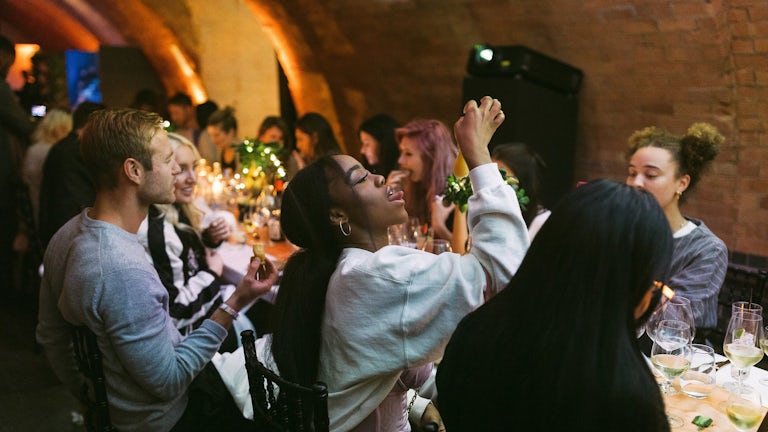Shopping Bag (0)
Your shopping bag is empty


The dynamic between young people, food, drink and socialising is a changin’. From setting food culture trends, being a key player in the decline of Britain’s booze habit or using gastronomy as a form of entertainment and expression – youth are shaking up the intersection between these factors to make it into something that’s far more palatable to them.
Young people make a multi-million person dent in the global food market, and also make up the largest segment online – meaning convergence between eating and being social online has reached a new high. That’s not all that’s changing though. Young people are setting food culture trends like never before, and their exploration of alternative eating trends is rising fast.
Ella Mills, more commonly known by her Instagram handle, Deliciously Ella, is a prime example of how young people can turn eating and the online world into a recipe for success. She recently hit 1.1 million followers on her Instagram account, which is dedicated to her unique brand of healthy eating, and posted to her clean-eating devotees:
We’re also seeing big changes in how young people choose to shop for food. Instead of relying solely on themselves, they tap up social and friends for where and what to buy. They’re spend savvy too - using mobile to make grocery purchases, check prices, download coupons, order ahead and gather product info.
During our Young Blood research, there was one phrase on the lips of almost everyone we spoke to.
“If you don’t take a photo of it, it hasn’t happened.”
Don’t take it for gospel – the younger generation isn’t manically documenting every single yoghurt or slice of toast they chow down on. However, eating and tweeting is certainly a thing; 54% of 18-24 told us that they’d captured their food on camera when eating out. 39% went on to post it online. That’s a lot of pixels at work. To top it off, 90 photos hashtagged #foodporn are uploaded to Instagram every minute – that’s a lot of sharing plates.
The world we live in now means that foodies never eat alone. They enhance their food experiences with a side of social media; 47% of 18-25 year olds have used a social network or texted while eating, most often during lunch.
Because you can broadcast every last bite to the world, no one ever truly sits at a table solo. Factors like this means that gastronomical voyeurism is on the rise; Food photography crosses multiple social platforms, including Facebook, Pinterest, Twitter and Instagram. Not to mention all the dedicated “Foodtography” websites, like Foodspotting, and the 2,500- member Foodtography group on Flickr.
But it’s not just about being social online. Young people are physically social when eating and when they’re weighing up what to purchase. They like to do the ‘big shop’ with mates, like to sit at communal tables, and opt for eat with pals and co-workers to instead of plumping for family nights out. Choosing to go solo means there’s almost endless opportunities for recommendations, chances to try new foods and the opportunity to share an opinion on what you think is hot to have on your plate.
Young people don’t just treat food as a treat for the taste buds. Nope. It’s cerebral too. Tech is at the heart of how this generation learns and reads about food. We’re seeing way more time spent on reading up on the stuff that fills your belly online (46%) than in print (31%). 40% of the people we spoke to told us that blogs, websites and apps are the places they turn to learn more too.
We’ve already talked about the Deliciously Ella effect on Instagram, but that’s the tip of the iceberg when it comes to learning more about food online. Consuming food content is often a rich experience (on the eyes, not the belly). Take Tasty for example, the notoriously popular food arm of BuzzFeed. In 15 months, Tasty created 2,000 recipe videos that (in aggregate) reached 500 million people a month—and the brand counts over 80 million fans on Facebook too. Their birds-eye view videos combine written recipes with the ingredients being measured and mixed in front of their eyes, removing the chef and putting the viewer in the centre of the action.
Rather than treating eating as a basic human function, we’re seeing young people take a different approach. They’re elevating meals that are eaten out to an almost competitive sport. This helps contribute to their notion of ‘The Brand of Me’. Young diners will proactively seek out casual restaurants that are newer and trendier in order to elevate their personal brand.
“There is this kind of bizarre balance within the generation because on the one hand, we’re broke, at the moment. But, we were more likely than generations before to have been raised with money. So, we have this taste for rocket and prosciutto, even though we’re making £20,000 a year.”
Though this generation earn less than the previous two that grew up before them, this generation is significantly more likely to visit upscale casual-dining restaurants. This may be in part related to differing attitudes towards where their money is best spent, but we’ve also seen the media judge it as food being a “playground for one-upmanship” and “a measuring stick of cool.”
“I feel like one reason that young people, or really, people, obsess over food is that it lets people have social currency. It’s a way of showing off.”
As chef Massimo Bottura puts it, “The food trend for 2017 is not an ingredient but an attitude”. However, it’s clear young people are already ahead of the curve - turning food into a different dish, with whichever toppings take their fancy.